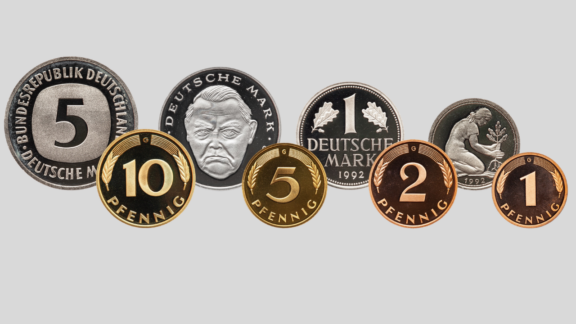The only official currency used in Germany today is the Euro.
Although the idea of a European currency had been around since at least 1929, it’s only been in circulation since 2002. Before the introduction of the Euro, Germany had used the Deutsche Mark (DM or D-Mark) since the unification of the country in 1990. In the years prior, West Germany used the Deutsche Mark and East Germany used the East German mark.
History of the German Euro
The use of the Euro in Germany is related to its status as a member of the European Union. West Germany joined the EU in 1958 and has remained a member ever since. The Euro was first adopted as a currency in 1999, although initially in a virtual, non-physical form. In 2002, physical bills and coins entered circulation in Germany and 11 other member states. Today, 19 of the EU’s 27 member nations use the currency. The countries make up what is known as the Eurozone or Euro Area.
Although the Euro is used officially in 19 different countries, each of these has a unique design on the coins it mints. The side of the coin that shows its numerical value is the same for all countries, but the design on the opposite side varies by country. The paper notes are identical in design.
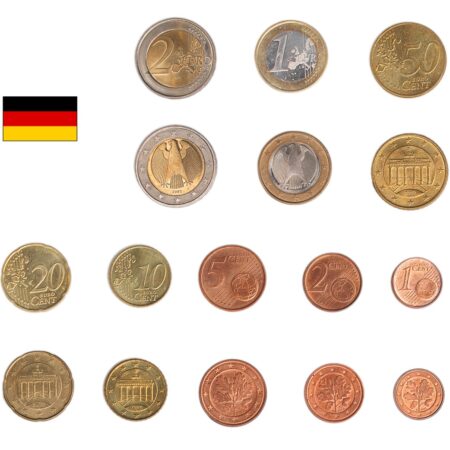
German Euro coins feature three different designs that were developed by officials and experts in numismatics. The first of these designs can be found on the €1 and €2 coins: an eagle, a long-used symbol of German sovereignty, occupies the center of the coin, and the stars of the European Union border the coin.
The 10, 20, and 50-cent coins feature a depiction of the Brandenburg Gate. This is a significant image in Germany because it represents the unification of the country and Europe as a whole. It is Germany’s only surviving city gate, and it symbolized the division of East and West Germany during the Cold War. Today, it symbolizes the reunification of the country.
Euro Notes and Designs
Since the beginning of the euro’s circulation in 2002, there have been two series of very similar designs for the paper notes: the First series and the Europa series. While there are small differences between the two designs, such as the inclusion of the Cyrillic spelling of “EURO” to account for Bulgaria’s inclusion in the European Union, the basic designs and colors are the same.
Instead of depicting actual people or landmarks on the bills, the design for each denomination represents a certain architectural style, as listed below:
- €5: Classical
- €10: Romanesque
- €20: Gothic
- €50: Renaissance
- €100: Baroque and Rococo
- €200: 19th Century Iron and Glass Architecture
- €500 (only printed in the First series): Modern 20th Century Architecture
Windows and doorways were chosen to showcase these different architectural styles because they represent a spirit of openness and communication between the people and countries of Europe and the wider world.
On the other side of all euro notes is a map of Europe that is consistent across all note denominations. This map changed slightly with the introduction of the Europa series to include Malta and Cyprus. There are also smaller islands such as Madeira, the Azores, the Canary Islands, French Guiana, Guadaloupe, Martinique, and Reunion included in the corner of all notes. These are islands that are outside of Europe, but that use the euro as currency.
The largest euro notes currently in circulation are the 200 and 500-euro bills. The 500-euro note is the largest in circulation, but new notes in this denomination are no longer being issued in the euro area.
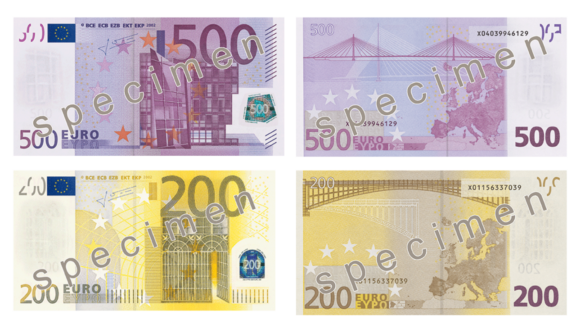
Below are examples of the 50 and 100-euro notes. There are more 50-euro notes in circulation than of any other denomination; their value totaled more than €672 billion at the end of 2021.
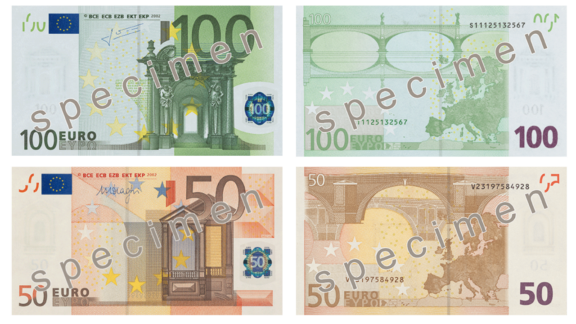
€20 notes are blue and feature an image of windows in the Gothic style. The €10 note is a light red color which depicts a Romanesque Gateway.
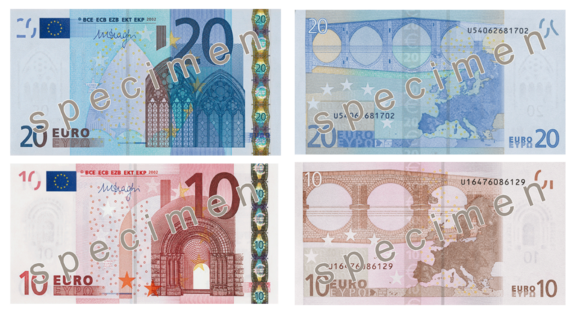
The smallest euro note is the €5 bill, which also accounts for the smallest share of the total value of euros in circulation. The bill is a gray color which shows a gate built in the classical style. In the image below, the 5-euro note is depicted, as well as German Euro coins.
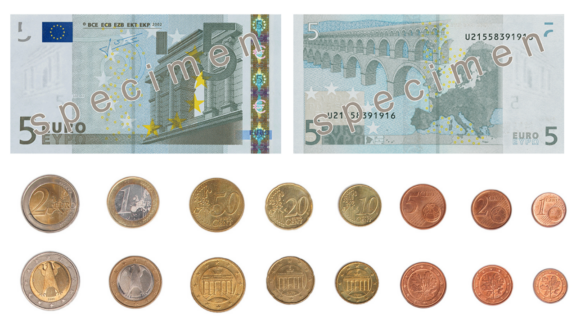
How much is $1 US in Germany?
$1.00 is worth about €0.97 as of August 2022. The exchange rate between the United States Dollar and the Euro is constantly changing. During 2021, the value of $1.00 averaged €0.85.
Does Germany use dollars?
The only official currency in Germany is the euro. Dollars have never been an official form of currency in the country, and the euro has been used across the country since 2002.
Should I take cash to Germany?
It can be helpful to have some Euros on hand when you arrive in Germany, but it isn’t necessary in most cases. Withdrawing cash from an ATM in Germany is easy, and there are many ATMs in public places. Waiting until you enter Germany to withdraw cash can save you from poor exchange rates obtaining euros outside the Eurozone.
Many establishments accept payment in the form of credit or debit cards, but German businesses do more businesses in cash than other European countries, so you’ll likely need to have some on hand to pay when cash is the only accepted payment method.
Does the 500-euro note still exist?
The 500-euro note still exists and is still in circulation, but new bills are no longer being printed. The note is much higher in value than exists in most other currencies, and this has led to its utility among criminal organizations.
While the note is still in use and legal tender in all Eurozone countries, all transactions involving the 500 Euro note in Denmark are prohibited.
How do I pay in Germany?
Paying for goods and services in Germany works much like it does in the USA and in other European countries. The euro is the legal tender, and payments can often be made with cash or card.
Visa, Mastercard, and others are widely accepted throughout the country, but there are establishments that will only accept cash payments for bills under a certain amount and those that won’t accept card payments at all.
Is paying by card normal in Germany?
Paying by card is growing in popularity in Germany, but cash payments are made more than in other European countries. A variety of cards are accepted widely throughout the country, but there are still businesses that will only accept cash payments or won’t allow purchases by card under a certain amount. Having some cash on hand is advisable.
The German Mark (Deutschmark)
Before the adoption of the Euro, Germany used the German Mark, or Deutsche Mark. It was commonly referred to as the Deutschmark, D-Mark, or DM in English. The word “mark” comes from a Germanic word that was used as a unit of weight. It was a common way to weigh gold and silver and was typically equivalent to eight ounces. Today, the only country that uses this name in its currency is Bosnia and Herzegovina, which uses the Convertible Mark.
The German Mark was notable for being a strong currency and for offering stability and economic security to Germans in the decades after World War II. Because of this, more than half of Germany’s population reported that they would choose not to change their currency over to the euro at the time of the change. There is even a memorial stone dedicated to the German Mark in the northern German town of Gifhorn.
Deutsche Mark Design
The design of various Deutsche Mark banknotes can be seen below for denominations of 10, 20, 50, and 100. Bills as high as 1,000 DM were issued when this currency was in circulation.
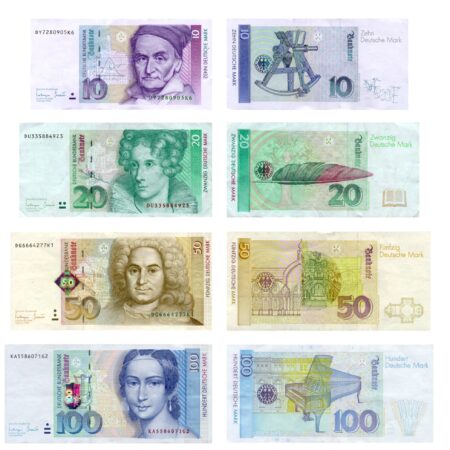
The 10-mark note was a blue-purple color and featured an image of Carl Friedrich Gauss on one side and a sextant on the other. Gauss was a German physicist who made significant contributions to the fields of math and science. A sextant is an instrument used for celestial navigation that Gauss would have used.
The 20-mark bill was green and displayed a portrait of poet Annette von Droste-Hülshoff on one side and a quill and Beech Tree on the other. The image of a Beech Tree is an allusion to one of her poems titled Die Judenbuche, or “Jews’ Beech Tree” in English.
The 50-mark paper note shows the face of Baroque architect Balthasar Neumann on one side and two buildings he designed on the other: the Würzburg Residence and the St Benedict abbey church in Neresheim.
On the 100-mark note is Clara Schumann, a poet and composer from Leipzig, Germany. She was considered one of the best pianists of the Romantic era and lived until 1866. On the opposite side of this bill is a grand piano at the Hoch Conservatorium in Frankfurt. This is where Schumann taught piano for several years.
Below is an image depicting the various coins that were used in the DM currency system. Marks were further broken down into pfennigs. One mark was equal to 100 pfennigs.
